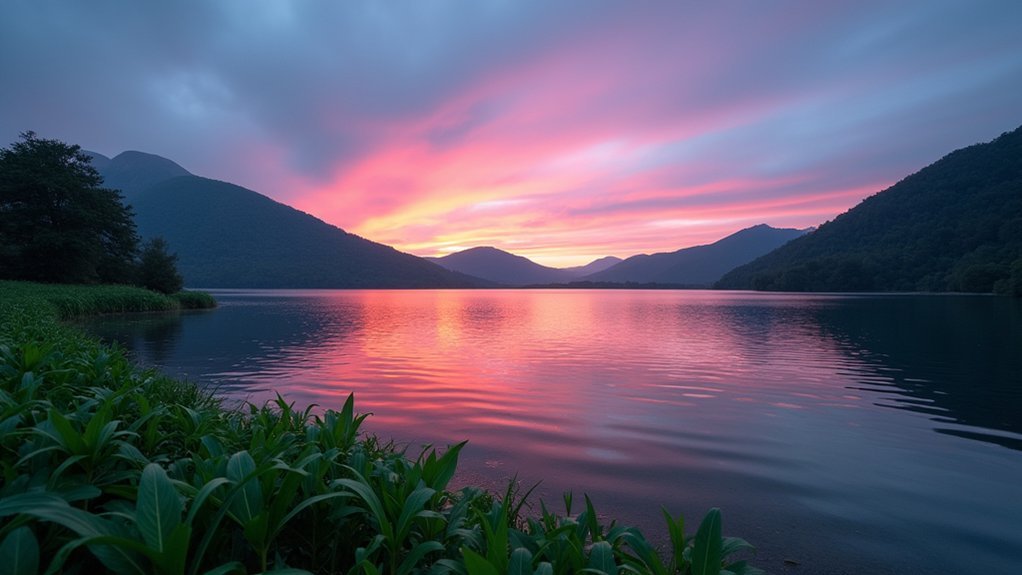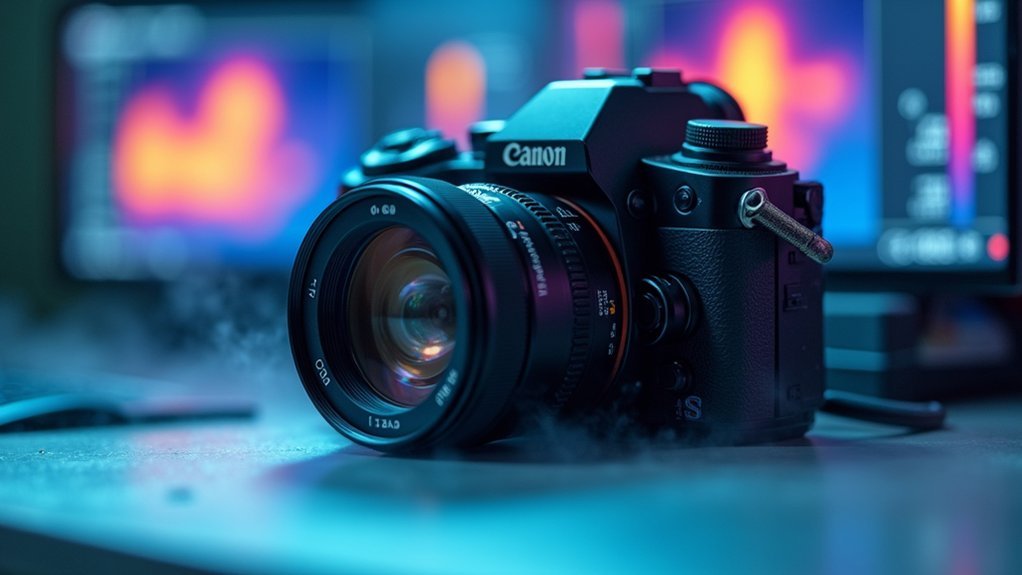To reduce image noise naturally, try these three effective techniques: First, use frame averaging by capturing and stacking 10-20 images to greatly improve your signal-to-noise ratio. Second, implement optical filtering with high-quality polarizing or ND filters to control light reaching your sensor. Third, manage your camera’s temperature by shooting in shade or using cooling methods, as heat considerably increases noise. These approaches deliver cleaner results without sacrificing image quality – discover how they transform your photography.
Frame Averaging: Multi-Capture Stacking Methods

While single-shot photography often struggles with noise in challenging light conditions, frame averaging offers a powerful solution to greatly enhance image quality. This multi-capture stacking technique works by combining multiple frames of the same scene, effectively reducing random noise while preserving image detail.
Frame averaging transforms noisy single shots into clean, detailed images by stacking multiple captures of the same scene.
For ideal results, you’ll want to capture at least 10-20 frames, though more is better, especially when shooting at high ISO. The process works by averaging pixel values across multiple exposures, considerably improving the signal-to-noise ratio.
Try incorporating dithering—slightly shifting your camera position between shots—to further enhance noise reduction by randomizing pixel positions.
This technique proves particularly valuable in astrophotography, where it can reveal celestial details otherwise hidden beneath noise, resulting in cleaner, more detailed final images.
Optical Filtering Techniques for Pre-Acquisition Noise Reduction
Before you even press the shutter button, optical filters can greatly reduce noise by controlling the light that reaches your camera’s sensor. ND filters allow you to shoot at lower ISO settings in bright conditions, immediately improving your signal-to-noise ratio.
When shooting outdoors, polarizing filters enhance contrast and eliminate reflections, enabling your sensor to capture cleaner data. For long exposure photography, consider infrared filters that block specific wavelengths contributing to noise.
Even UV filters serve a purpose beyond lens protection—they reduce atmospheric haze that might otherwise introduce noise in challenging conditions.
The key is investing in high-quality optical filters that maintain image integrity by allowing only desired light to reach your sensor.
This pre-acquisition noise reduction strategy means your RAW files start cleaner, giving you a significant advantage in post-processing.
Temperature Control Strategies for Minimizing Sensor Noise

Since heat generates electrical interference within camera sensors, temperature management represents one of the most effective yet overlooked noise reduction techniques.
You’ll achieve cleaner images by keeping your sensor cool, especially during long exposures when thermal noise accumulates rapidly.
Consider investing in a cooled camera or implementing external cooling techniques like peltier coolers to lower sensor temperatures and improve signal-to-noise ratios.
For DSLR users, allow your camera to cool for a period equal to your exposure time. Between shots, practice dithering—slightly shifting your camera position—to help average out hot pixels when stacking images later.
Operating in a controlled environment, such as a shaded area, can minimize image noise by preventing temperature increases.
This approach is particularly valuable for astrophotography, where thermal management makes the difference between mediocre and stunning results.
Frequently Asked Questions
How to Decrease Image Noise?
To decrease image noise, use the lowest ISO setting possible, shoot in good lighting, slightly overexpose, capture in RAW format, and utilize noise reduction software. You’ll see cleaner images with better detail preservation.
How to Reduce Noise in Raw Images?
To reduce noise in RAW images, you’ll want to adjust the Luminance slider (start at 50) and Color slider in Lightroom. Use the Adjustment Brush for selective reduction, or try specialized software like Topaz DeNoise AI.
How to Make a Picture Less Grainy?
To make your picture less grainy, shoot with lower ISO, guarantee proper lighting, capture in RAW format, apply selective noise reduction in post-processing, and slightly overexpose your images to improve the signal-to-noise ratio.
How Do I Denoise the Image?
To denoise your image, use Lightroom’s Luminance slider (start at 50), apply selective reduction with the Adjustment Brush, or try Topaz DeNoise AI. Always shoot in RAW and check details while zoomed in.
In Summary
You’ve now discovered three powerful ways to combat noise without relying on software filters. By combining frame averaging, optical filters, and temperature control, you’ll capture cleaner images directly in-camera. These natural techniques preserve detail while reducing unwanted noise. Try implementing just one method first, then gradually combine all three for dramatically improved image quality in even the most challenging lighting conditions.





Leave a Reply